Ford vs. Ferrari 101: The ‘60s battle, in a nutshell for our younger readers. It was, after all, a half century ago.
By Wallace Wyss
Historic Images courtesy of Ford Motor Company
It started only after Henry Ford II, who wanted to impress his beautiful Italian wife by buying an Italian automaker, got the door slammed on his face by Enzo Ferrari.
Embarrassed by the failed offer, he vowed to set his minions to work making an all new endurance racer that could win the 24 Hours of Le Mans, Europe’s most important race and defeat Ferrari in the process. It is a remarkable story of American will-power, teamwork (and of course money).
To get the project rolling, Ford purchased two of Eric Broadley’s Lola racecars, coupes coincidentally powered by a small block Ford 260 cid. The new Ford GT did not copy Eric Broadley’s car exactly, though it was close enough that parts from the GT40 prototype were able to be tested on Lola’s GT. Ford’s point man was Don Frey, who assigned Roy Lunn, a native British engineer, to head up development of the endurance racer.
The car was called the ‘GT40’, a nickname derived form it being forty and one half inches” tall. The engine was a 260 cid Ford with an aluminum block. Ford thought that was powerful enough but they were wrong.
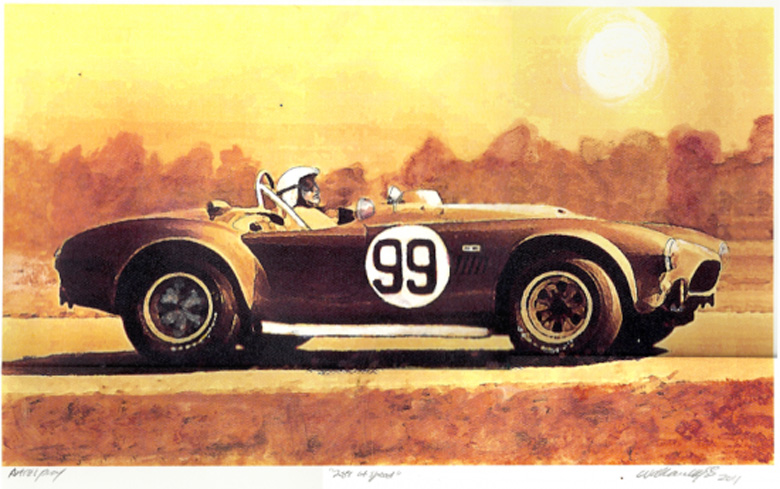
The sun was going down on the Shelby Cobra, but it was a new day for the Ford GT40. Art by Wallace Wyss.
Didn’t need Shelby at first
Ford meanwhile bankrolled Carroll Shelby’s efforts with the Cobras, including the small block 289 and big block 427 and the svelte coupe, the Daytona. Ford eventually won the Championship in ’65 with the Cobras but by that time they were deep into trying to win overall at Le Mans so it hardly mattered to them.
Oddly, though Carroll Shelby had driven the winning Aston Martin at Le Mans in 1959, Ford figured they didn’t need this rube (who had been a failed chicken farmer when he took up racing in the early ‘50s) in the initial stages of the GT40 development. After all, the Cobra’s development was decidedly Mickey Mouse, barely better than hot rodding.
Ford needed expertise in managing an International race team, so they hired ex-Aston Martin team boss John Wyer, who had been in charge of Aston’s racing program when Shelby won the race for them in ‘59.
The GT40s were designed in Dearborn but built at a new firm Ford started called Ford Advanced Vehicles located in Slough, UK. a few steps away from Lola. Ford built some prototypes and Ken Miles and Bruce McLaren were hired, driving prototypes as early as August 1963. A British factory, Abbey Panels, made the fiberglass body. Ford was anxious to show it to stockholders in the U.S. and flew that first completed car to New York for an unveiling the day before the New York auto show, in April 1964.
That first season, though, was a disaster. The engines couldn’t rev as high as Ferrari; and even though they had dry sump lubrication like Ferraris, they couldn’t hold together. The Colotti Italian-made gearboxes malfunctioned. The Borrani wire wheels snapped spokes under side loads. Despite failure after failure, Ford insisted on running them in three major events – the Nürburgring 1000km, the Le Mans 24 hours and the Reims 12 hours, all of which resulted in DNFs. They were intent on learning the flaws of the GT40 despite the shame of losing.
Ford had thought they had an aerodynamic design but on the Mulsanne straight the noses were lifting the front tires right off the ground so front spoilers were hastily added. They could top 200 mph but became unstable at 170 mph. Richie Ginther suggested a tail spoiler and that helped keep the rear end planted.
Enter Carroll Shelby, again
After the 1964 season, Ford Dearborn revved up their relationship with a secret race shop they often used in Dearborn, Kar-Kraft. Though Wyer was technically still in charge of building the cars, Carroll Shelby was told to leave the Cobras aside and join the Le Mans effort.
Shelby hired his old racing mechanic buddies, some good ol’ California hot rodders like Phil Remington and got the job done. Along the way, he modified the existing GT40.
A big push was squeezing in the huge 7-liter 427. Why? Because the 427 had proved golden in NASCAR. It could pump out over 400 hp without breaking a sweat. Out went the Italian Weber carburetors; only made-in-America four-barrel Holleys would do. Out went the unreliable Italian-made four speed manual; a new Ford transaxle was developed, including an automatic.
The racing world saw the changes that Shelby wrought at Daytona in 1965, when one of the big block MkII GT40s finished first, with Ken Miles and Lloyd Ruby sharing driving tasks. But the future victory at Le Mans wasn’t predictable yet, as, at Sebring they lost again, but it was at Le Mans Ford officials saw much egg on the face, as all five GT40s failed to finish. Meanwhile Ferrari scored first with a 250LM that wasn’t even a factory entry. It was Ferrari’s ninth win there but was to be their last overall win at Le Mans to date; Ford was gaining ground rapidly.
“WIN OR ELSE”
Henry Ford II sent a few memos down from the top floor to the race team after the ’65 Le Mans failure. One succinct note said simply “Win or else.”
And by early 1966, Ford, with Ken Miles at the wheel of a GT40, won at Sebring. Ford’s warnings must have worked.
Ford tested the Ford GT engines for Le Mans like no race engine they had ever developed, having row upon row of cars sitting on dynos with the engines running wide open for 24 hours. The primitive computers even simulated the gearbox changes so in effect the cars were doing laps though tethered to the dyno.
Old timers remember that late at night around Dearborn that spring, you could hear those engines winding to redline hour after hour (and occasionally blowing up in the process).
In 1966 Ford came back to Le Mans back with several teams, only one of which was run by Shelby. That allowed for different management styles. They were friendly competitors, so to speak. Though it was an American effort, the best drivers were hired from all over the world, even some from NASCAR ranks.
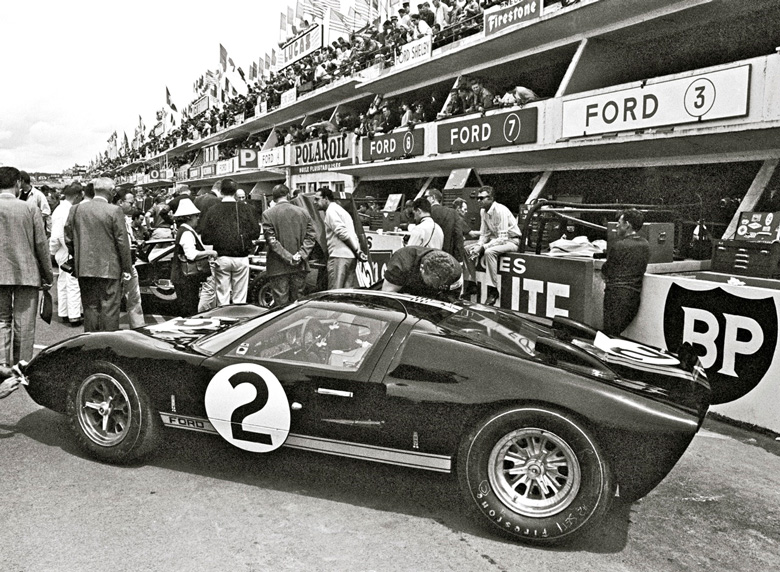
The 1966 Mk. II big block looked similar to Mk. I but had two scoops on each side as well as rear deck intakes.
Ford showed up with a huge crew; 100 crewman, nine cars, seven spare engines, and 21 tons of spares.
Henry Ford II was there on site, keeping the pressure on Leo Beebe, head of Ford’s racing program.
Ferrari thought Ford’s cars were overweight, clumsy, and unreliable. Italian sophistication would dominate!
But it was the Ferrari works cars that fell by the wayside. After 24 hours of total domination, as a publicity stunt, Ford began to move the positions of their racers so that there would be a memorable finish, three cars across the finish line at once, all Fords. A nasty bit of news came when Ken Miles, who had been in the lead, was ordered to drop back for the planned three-abreast finish. That allowed Bruce McLaren, in another of the team’s GT40s, to jump in the lead, a position he held when the finish flag fell. So McLaren (whose co driver was Chris Amon) “robbed” Miles of the victory. But Ford didn’t mind, it was the company name that got all the publicity.
One More Season
After that victory, Ford decided to bankroll one more season, just to show that their first victory at Le Mans was no fluke. They developed an all new car but sadly Ken Miles was killed testing one at Riverside.
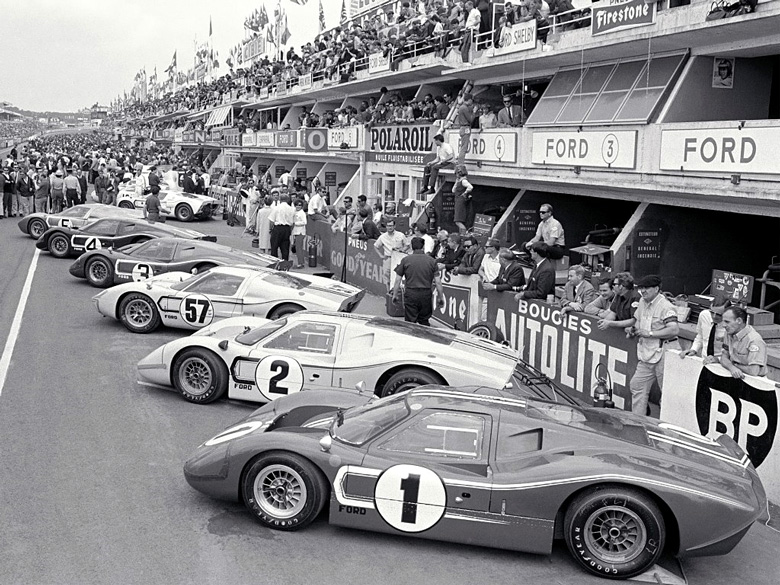
If it’s nice do it twice, but make sure you come fully loaded. The 1967 Le Mans line up was formidable.
A safer model was developed, with a roll cage and restyled. It was dubbed the Mk. IV.
There was some worry after Daytona in 1967 when Ferrari 330 P4s took a 1-2-3 finish. But that was just a flash in the pan. Ford poured in ever more money and the Mk. IV won Le Mans in ’67 with Indy 500 icon, A.J. Foyt, sharing seat time with a former Shelby racing rival and sometimes contract driver, Dan Gurney.
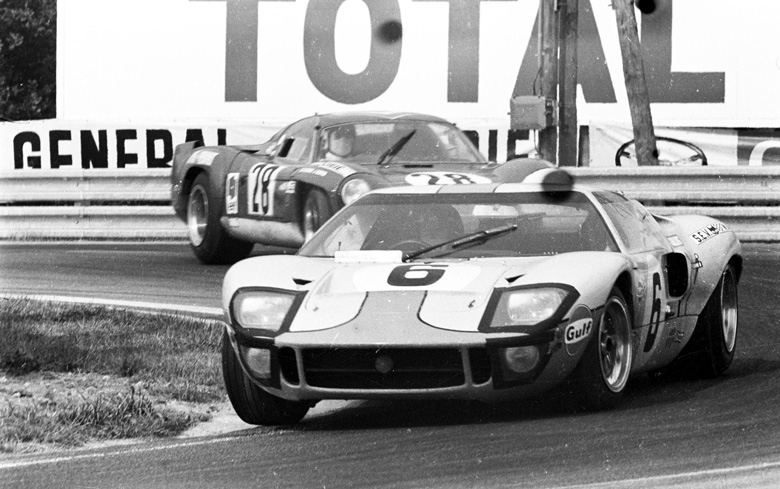
Gulf-sponsored GT40s continued Ford’s winning ways at Le Mans. Here Jackie Ickx and Jackie Oliver teamed in the GT40 to win again in 1969.
When Ford finally pulled out of endurance racing after the ’67 Le Mans win, it was Gulf Oil who wrote a check to John Wyer to run the GT40s with a new 5-liter Ford at Le Mans. Wyer’s light blue Gulf Oil-themed racers won Le Mans victories in 1968 and 1969, setting a four-year winning streak for Ford GT40 derived cars.
Shelby and Ford grow apart
The public didn’t realize how far apart Shelby and Ford had grown after ’67. During this time Ford was still capitalizing off their Le Mans victory, running ads for Shelby Mustangs, and stressing the tie-in between the Fords in the showrooms and Le Mans. Shelby Mustang production was moved to Detroit suppliers and Shelby faded out as their spokesman, though he made a re-appearance for Ford managing some Trans Am efforts.
Shelby’s days at Ford were numbered once Ford had the Boss 302, a real performance car, while the Shelby Mustang had become overpriced and overly heavy with options.
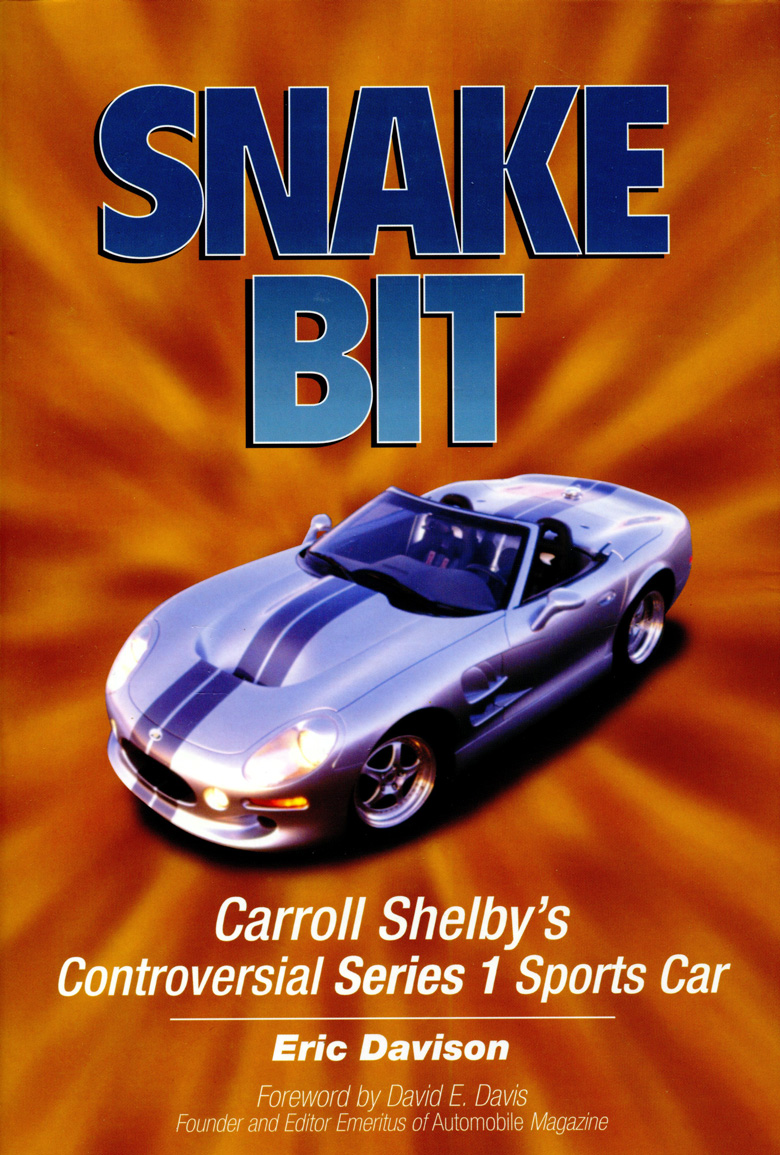
The full story of Shelby’s misadventures in building the Shelby Series 1 is told by VeloceToday contributor Eric Davison in this remarkable book.
Shelby went off to Africa where he managed a game preserve. But Shelby came back from Africa after he lost his game license and had a variety of companies, including a mag wheel company, a tire distributorship, and seemed happy to be out of the car making business. Then the replica Cobra market was spawned and Shelby was chagrined that others were making money with a car he invented, so much so that he got into it himself. Then, convinced that he wasn’t thought of as a real automaker unless he made a modern car, he got into a modern design with an Olds-powered car that was a total flop and lost him over $2 million of his reported $5 million net worth.
And so it was; Ford proved that they could go into the European racing arena and come out a winner over one of the greatest names in European racing. But it took a failed chicken farmer to do it…
CASTING CALL FOR FORD VS FERRARI MOVIE (but alas, only if you live near Savannah) If you are interested in appearing in the movie, Ford vs Ferrari, click below for the story and where to send your pictures.
———————————–
THE AUTHOR: Wallace Wyss is a noted historian on the Ford vs. Ferrari era. Re film rights to his books, he can be reached at Photojournalistpro2@gmail.com
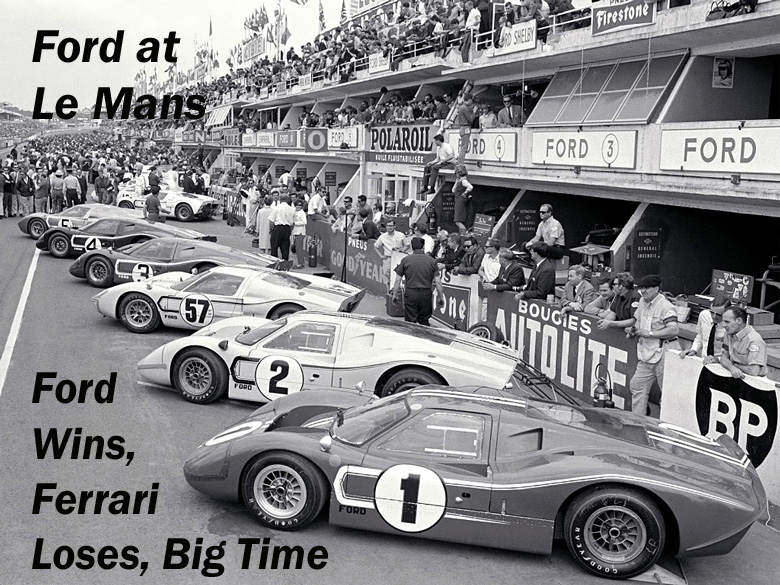
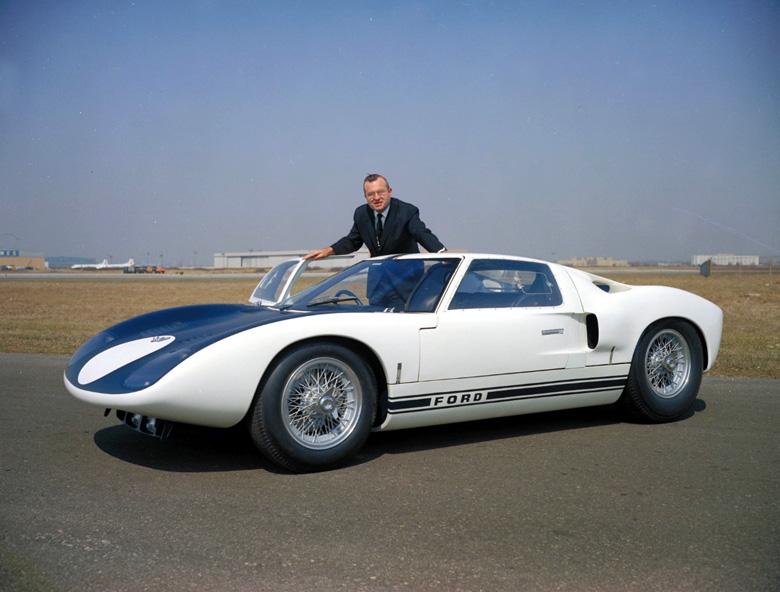
Terrific story. Why not give credit for Ferraris last Le Mans win in a 3 year old rent A racer. N.A.R.T. 65 Le Mans. Mr.Ferrari was pissed the old N.A. R.T.car would not slow and let the new Factory cars win. Chinetti’s third Le Mans win !!!Bravo ???? Ferrari expert and N.A.R.T. employee Ted Johnson for 27 years has numerous photos and stories hope he writes THE book soon. Anna Marshall yachts, Erin Profita, tom I. davis. palmbeachtidemuseum dot com T.I.D.E. ferrari racing, LAST Ferrari car owner / team to finish in top 5 and win class at Le Mans. 81 Le Mans 5 th. O.A. IMSA class winner. T.I.D.E. pozzi ferrari France. Ferrari I.D. 512BBLM # 31589 Team and ferrari owned and raced by tom I. davis enterprises, Sept 1980- July 1989. Please help save old palm beach and the Historic Poncina Playhouse with Harvard’s Simon Taylor, Esq. from the hit and run carpetbagger builders, AGAIN !!!
Yes, there is a story there, even more of a story that Ed Hugus, ironically Shelby’s first dealer for Cobras, volunteered to step in and drive until they could round up Rindt. He wasn’t listed as a driver of the car and couldn’t take credit for it, but he himself told me he did it. You wonder what the Ford officials thought back in the pit! So you wonder if this Ford vs. Ferrari film is made, if it will spawn more detailed stories on this era and the Chinetti team’s victory will receive its own spotlight.
About that live theatre, all for it, but I know those real estate interests–willing to gut the town of what makes it unique to sell another condo!
You do the great Bruce McLaren a huge injustice. The reason he was awarded the race was not because he overtook anyone at the finish line.
It was because he started the race further down the grid, therefore he travelled a longer distance in the 24 hours. It was the Ford officials or in fact Henry who cost Ken Miles his victory, dam shame he died a few months later.
Geoff Burgess
Australia
I understood Miles was told to slow down, so that robbed him of bring in first where McLaren didn’t I feel it was Ford wanting a spectacular finish that led to that fiasco but from Ford’s viewpoint it wasn’t that important, Ford won and which driver won didn’t matter as much